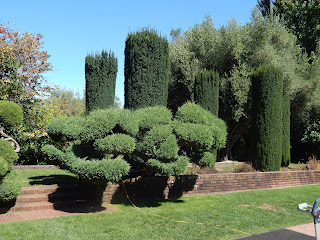Many of you no doubt have visited the wonderful and unique Filoli Gardens in northern California. A friend and I went today and had a leisurely visit. Although spring is the busy season - people being drawn by the magnificent bulbs display - the garden offers much throughout the year. Here are photos taken of the visit today, with the briefest of commentary when needed.
Southern magnolia (M. grandiflora). This mammoth magnolia just dominates the landscape!
These next 4 photos are of the iconic Sunken garden, near the entrance. This area is smothered in bulbs in the spring but still yields pleasures year round. This year the color purple made for a strong color scheme.
It happened that our visit coincided with an art installation by the nature artist W. Gary Smith called "Nests." As the brochure notes "Gary's exhibition features forms inspired by both patterns in nature and nesting animals. All the materials come from the Filoli estate - from wind-felled native oak trees to London plane tree branches gathered from the formal Garden." This first sculpture (in the sunken garden) is titled 'Water Circle' and uses London plane branches in an Arroyo willow ring.
Potted and sculpted conifer.
Globba winitii. This member of the ginger family has the most beautiful flowers. The light somewhat washed out this photo (I'd brought my point and click camera) but you can still get an idea of the bi-colored cascading flowers.
Also in this sun room were beautifully designed living floral arrangements. This one features the broad textured leaves of an unknown Philodendron species.
Though the Garden's famous Knot garden, comprised mostly of herb bushes, is a bit long in the tooth at this late stage in the year, you can still get an idea of its beauty.
The next 3 photos are of the fenced in Cutting Garden. Within are flowers grown for the many vases inside the main house. We surmised the fencing is a protection from deer.
Here are some colorful Celosias, which do indeed make a great cut flower (adding a colorful vertical element).
Lastly, here is a stand of Amaranth, with their familiar and gorgeous seedheads.
This Nests sculpture, the largest, is at the far end of the Garden known as the High Place. This is the 'Willow Dome,' featuring a skeleton of steel rings from Filoli's 100 year old water tanks and Arroyo willow branches woven together. My friend and I were both reminded of the work of the environmental artist Andy Goldsworthy (though his sculptures of natural objects were built as temporary structures, to be erased by tide, wind or heat).
This double row of trees show off the formal bones of the Garden.
One of the day's surprises was coming across a row of English ivy bushes. Some were in bloom, as was the case here, and to our great surprise the flowers were being swarmed with bees. We later learned that the Garden was bequeathed one of the world's largest collections of English ivy.
Though the Nests installation were all mostly made from repurposed wood, there were a few other sculptures in the garden, such as this metal sculpture entitled 'Ascension.'
This Nests installation formed a dipping and rising border to one of the paths in the Woodland Garden. The half dozen pieces in this area were a collaboration between Smith and students in Santa Clara University professor's Ryan Carrington's course (titled "Site Specific Art: Landscapes).
Seeming a bit out of place, this stone statue of what looked like a Pan figure, was just resting in the Woodland Garden. Well, I guess if he was to be anywhere it would be in the woods ...
Dicksonia tree fern. Just wonderful woodland denizens.
Another of the above mentioned art installations is this collection of wood pegs tied together with what presumes is a vine of some sort. They reminded me of wind chimes (though silent).
The next 3 shots are part of the Nests exhibit. These were meant to suggest Bowerbird nests. Bowerbird males are famous for building elaborate nests to attract females, albeit on the ground. As the photo below shows, there were a good dozen of these nests as part of this installation.
The Bowerbird nests were hanging from this tree, which features knots and gnarled branches.
A bit out of place perhaps but this clock tower still stands as an imposing sentinel. The first shot shows its surroundings while the shot below is more of a closeup.
Golden honey locust tree (Gleditsia triacanthos 'Sunburst'). It sure stands out among the muted colors of most of the rest of the trees. It's located just beyond the pool area.
This gives more of an idea of the formal aspects of the garden, seen most apparently in the way certain shrubs and trees have been pruned.
Here's a view of the sprawling main house, from a side entrance view.
Though olive trees and various conifers dominate the selection of trees, there are quite a few oaks on the property. Here's one giant oak tree located in the meadow.
Subscribe to:
Post Comments (Atom)
































Not a Gleditsia anymore - Robinia pseudoacacia 'Frisia'!
ReplyDelete